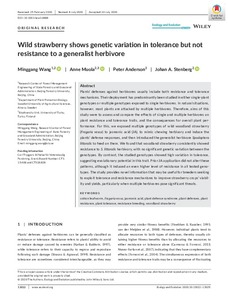Wild strawberry shows genetic variation in tolerance but not resistance to a generalist herbivore
Wang MG; Muola A; Anderson P; Stenberg JA
Wild strawberry shows genetic variation in tolerance but not resistance to a generalist herbivore
Wang MG
Muola A
Anderson P
Stenberg JA
WILEY
Julkaisun pysyvä osoite on:
https://urn.fi/URN:NBN:fi-fe2021042823089
https://urn.fi/URN:NBN:fi-fe2021042823089
Tiivistelmä
Plants' defenses against herbivores usually include both resistance and tolerance mechanisms. Their deployment has predominantly been studied in either single-plant genotypes or multiple genotypes exposed to single herbivores. In natural situations, however, most plants are attacked by multiple herbivores. Therefore, aims of this study were to assess and compare the effects of single and multiple herbivores on plant resistance and tolerance traits, and the consequences for overall plant performance. For this, we exposed multiple genotypes of wild woodland strawberry (Fragaria vesca) to jasmonic acid (JA), to mimic chewing herbivory and induce the plants' defense responses, and then introduced the generalist herbivoreSpodoptera littoralisto feed on them. We found that woodland strawberry consistently showed resistance toS. littoralisherbivory, with no significant genetic variation between the genotypes. By contrast, the studied genotypes showed high variation in tolerance, suggesting evolutionary potential in this trait. Prior JA application did not alter these patterns, although it induced an even higher level of resistance in all tested genotypes. The study provides novel information that may be useful for breeders seeking to exploit tolerance and resistance mechanisms to improve strawberry crops' viability and yields, particularly when multiple herbivores pose significant threats.
Kokoelmat
- Rinnakkaistallenteet [19207]
